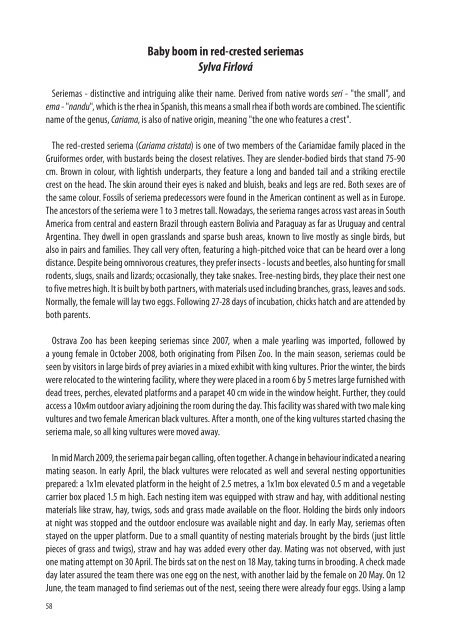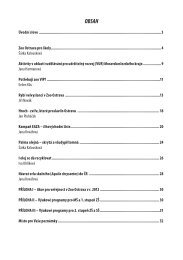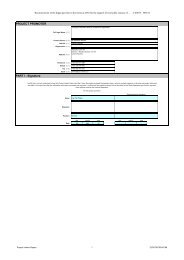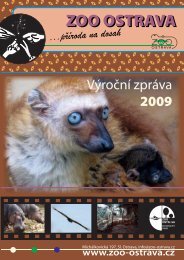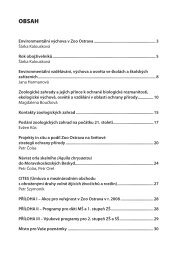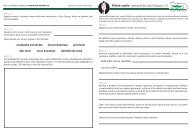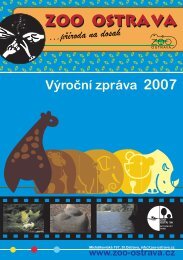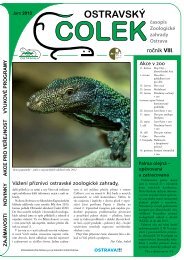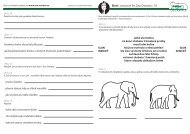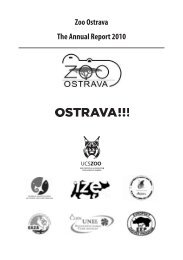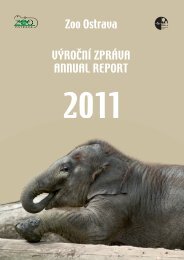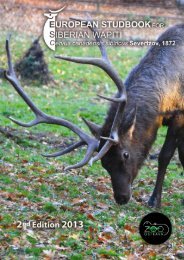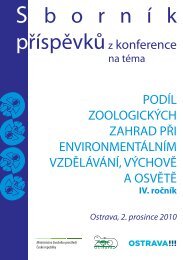You also want an ePaper? Increase the reach of your titles
YUMPU automatically turns print PDFs into web optimized ePapers that Google loves.
58<br />
Baby boom in red-crested seriemas<br />
Sylva Firlová<br />
Seriemas - distinctive and intriguing alike their name. Derived from native words seri - "the small", and<br />
ema - "nandu", which is the rhea in Spanish, this means a small rhea if both words are combined. <strong>The</strong> scientific<br />
name of the genus, Cariama, is also of native origin, meaning "the one who features a crest".<br />
<strong>The</strong> red-crested seriema (Cariama cristata) is one of two members of the Cariamidae family placed in the<br />
Gruiformes order, with bustards being the closest relatives. <strong>The</strong>y are slender-bodied birds that stand 75-90<br />
cm. Brown in colour, with lightish underparts, they feature a long and banded tail and a striking erectile<br />
crest on the head. <strong>The</strong> skin around their eyes is naked and bluish, beaks and legs are red. Both sexes are of<br />
the same colour. Fossils of seriema predecessors were found in the American continent as well as in Europe.<br />
<strong>The</strong> ancestors of the seriema were 1 to 3 metres tall. Nowadays, the seriema ranges across vast areas in South<br />
America from central and eastern Brazil through eastern Bolivia and Paraguay as far as Uruguay and central<br />
Argentina. <strong>The</strong>y dwell in open grasslands and sparse bush areas, known to live mostly as single birds, but<br />
also in pairs and families. <strong>The</strong>y call very often, featuring a high-pitched voice that can be heard over a long<br />
distance. Despite being omnivorous creatures, they prefer insects - locusts and beetles, also hunting for small<br />
rodents, slugs, snails and lizards; occasionally, they take snakes. Tree-nesting birds, they place their nest one<br />
to five metres high. It is built by both partners, with materials used including branches, grass, leaves and sods.<br />
Normally, the female will lay two eggs. Following 27-28 days of incubation, chicks hatch and are attended by<br />
both parents.<br />
<strong>Ostrava</strong> <strong>Zoo</strong> has been keeping seriemas since 2007, when a male yearling was imported, followed by<br />
a young female in October 2008, both originating from Pilsen <strong>Zoo</strong>. In the main season, seriemas could be<br />
seen by visitors in large birds of prey aviaries in a mixed exhibit with king vultures. Prior the winter, the birds<br />
were relocated to the wintering facility, where they were placed in a room 6 by 5 metres large furnished with<br />
dead trees, perches, elevated platforms and a parapet 40 cm wide in the window height. Further, they could<br />
access a 10x4m outdoor aviary adjoining the room during the day. This facility was shared with two male king<br />
vultures and two female American black vultures. After a month, one of the king vultures started chasing the<br />
seriema male, so all king vultures were moved away.<br />
In mid March <strong>2009</strong>, the seriema pair began calling, often together. A change in behaviour indicated a nearing<br />
mating season. In early April, the black vultures were relocated as well and several nesting opportunities<br />
prepared: a 1x1m elevated platform in the height of 2.5 metres, a 1x1m box elevated 0.5 m and a vegetable<br />
carrier box placed 1.5 m high. Each nesting item was equipped with straw and hay, with additional nesting<br />
materials like straw, hay, twigs, sods and grass made available on the floor. Holding the birds only indoors<br />
at night was stopped and the outdoor enclosure was available night and day. In early May, seriemas often<br />
stayed on the upper platform. Due to a small quantity of nesting materials brought by the birds (just little<br />
pieces of grass and twigs), straw and hay was added every other day. Mating was not observed, with just<br />
one mating attempt on 30 April. <strong>The</strong> birds sat on the nest on 18 May, taking turns in brooding. A check made<br />
day later assured the team there was one egg on the nest, with another laid by the female on 20 May. On 12<br />
June, the team managed to find seriemas out of the nest, seeing there were already four eggs. Using a lamp


